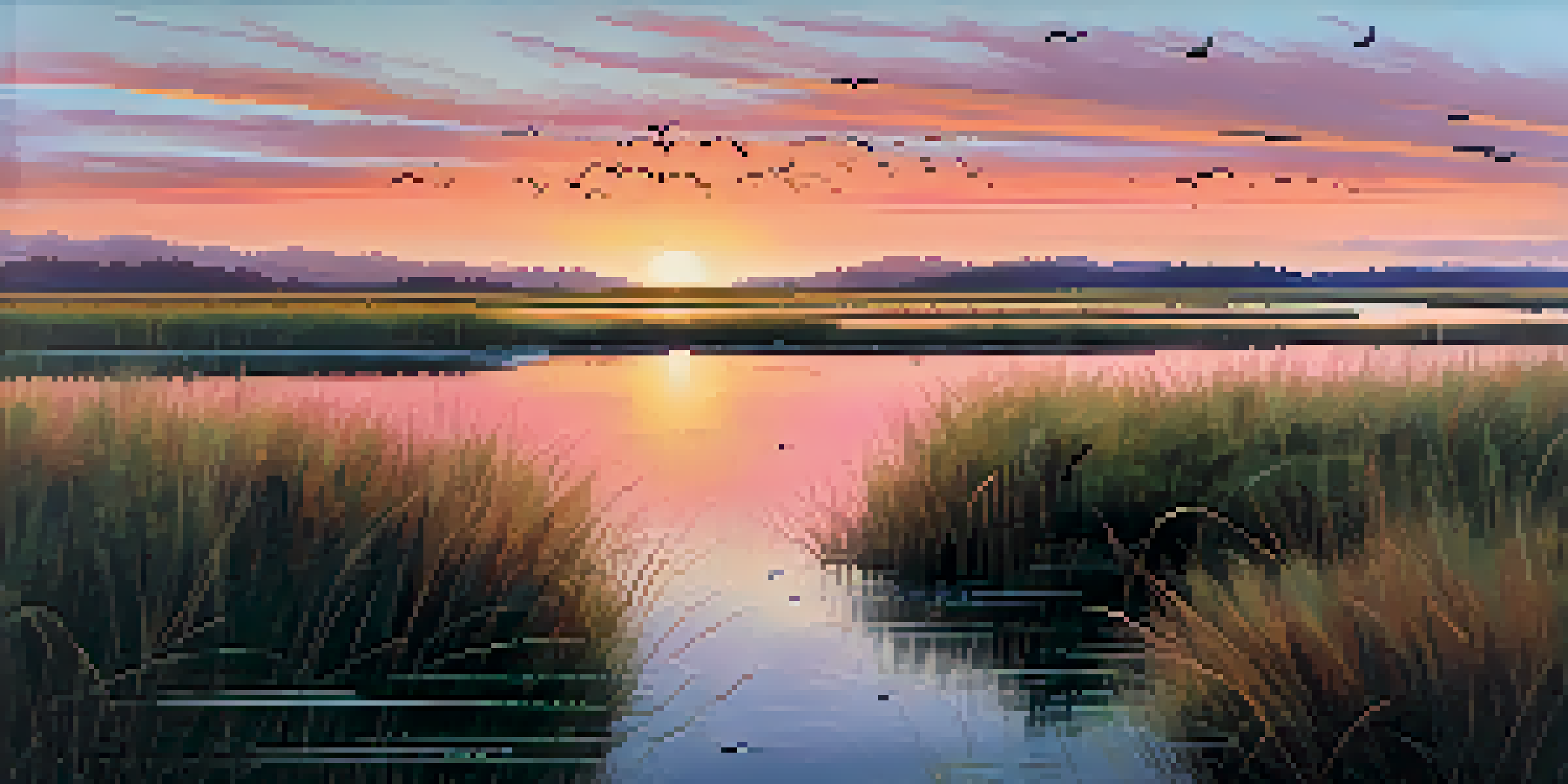The Importance of San Diego's Wetlands for Wildlife Protection

Understanding San Diego's Unique Wetland Ecosystems
San Diego's wetlands are a vital part of the region's natural landscape, encompassing salt marshes, estuaries, and freshwater marshes. These ecosystems not only provide essential habitats for a variety of wildlife but also play a crucial role in maintaining ecological balance. Think of wetlands as nature's sponge, absorbing excess rainwater and helping to prevent flooding while filtering pollutants.
Wetlands are among the most productive ecosystems on the planet, providing vital services such as water filtration and wildlife habitat.
Wetlands are home to countless species, from migratory birds to amphibians and fish, making them a biodiversity hotspot. For instance, the San Diego Bay National Wildlife Refuge serves as a critical stopover point for migratory birds along the Pacific Flyway. By understanding the unique characteristics of these wetlands, we can appreciate their role as a sanctuary for wildlife.
Furthermore, these areas support diverse plant life, which in turn provides food and shelter for various animal species. The intricate relationships between plants and animals in wetlands highlight the importance of conserving these ecosystems to ensure the survival of both flora and fauna.
The Role of Wetlands in Wildlife Habitat Protection
Wetlands act as essential habitats for many species, offering nesting sites, breeding grounds, and food sources. For example, the endangered California least tern relies on the sandy areas of wetlands for nesting, while many fish species breed in these protected waters. By preserving wetland habitats, we ensure the survival of these vulnerable species.

In addition to providing habitat, wetlands also serve as nurseries for various aquatic species, including fish and crustaceans, which are crucial for the local fishing industry. These juvenile fish find refuge in the shallow waters of wetlands, where they can grow and develop in relative safety. The loss of wetlands would not only threaten wildlife but also disrupt local economies that rely on fishing.
Wetlands: Biodiversity Hotspots
San Diego's wetlands support a diverse array of wildlife, making them crucial for maintaining ecological balance and preserving various species.
Moreover, wetlands buffer against habitat loss caused by urban development. By maintaining these natural spaces, we create corridors that allow wildlife to move freely between different habitats, which is essential for genetic diversity and resilience against environmental changes.
Wetlands and Biodiversity: A Vital Connection
Biodiversity refers to the variety of life forms within a given ecosystem, and wetlands are among the most biodiverse areas on the planet. They provide a rich tapestry of life, supporting various species that rely on these habitats for survival. The unique combination of water, soil, and vegetation in wetlands fosters an environment in which both plants and animals can thrive.
The loss of wetlands is a loss of life, biodiversity, and a significant barrier to climate resilience.
The interconnectedness of species in wetlands is fascinating; for instance, the presence of specific plants can indicate the health of the ecosystem. If certain plants are thriving, it's a good sign that the wetland is functioning well and supporting diverse wildlife. This intricate web of life showcases why protecting wetlands is paramount for biodiversity.
When wetlands are damaged or destroyed, the ripple effects can be detrimental, leading to declines in species populations and even extinction. Therefore, preserving these ecosystems is not only essential for individual species but also for maintaining the overall health of our planet.
The Impact of Climate Change on Wetlands
Climate change poses a significant threat to wetland ecosystems, affecting everything from water levels to species migration patterns. Rising sea levels can inundate coastal wetlands, while increased temperatures can alter the delicate balance of these habitats. This shift can disrupt the species that depend on wetlands, leading to declines in populations and biodiversity.
Moreover, changing precipitation patterns can affect the water supply in wetlands, leading to either drought or flooding. This unpredictability can further stress wildlife populations that rely on stable conditions for breeding and feeding. The resilience of wetland ecosystems will be tested as climate change continues to unfold.
Climate Change Threatens Wetlands
Rising sea levels and changing precipitation patterns due to climate change pose significant risks to wetland ecosystems and the species that rely on them.
To combat these challenges, conservation efforts must adapt to the realities of climate change. This includes restoring degraded wetlands, protecting existing wetlands from development, and implementing sustainable practices that can help mitigate the impacts of climate change on these vital ecosystems.
Conservation Efforts for San Diego's Wetlands
Numerous organizations and agencies are dedicated to the conservation of San Diego's wetlands, recognizing their importance for wildlife and the community. Initiatives range from habitat restoration projects to educational programs aimed at raising awareness about the value of these ecosystems. For instance, local nonprofits often organize volunteer clean-up days to help maintain and restore wetland areas.
Additionally, the collaboration between state and federal agencies helps implement policies that protect these critical habitats. Regulations that limit development in wetlands ensure that these areas remain intact for future generations. By working together, these groups can create a more significant impact on the conservation of wetland ecosystems.
Community involvement is also crucial in these efforts. Engaging local residents in conservation activities fosters a sense of ownership and responsibility toward preserving San Diego's wetlands. When individuals understand the importance of these habitats, they are more likely to advocate for their protection.
The Educational Value of Wetlands
Wetlands serve as outdoor classrooms, providing opportunities for education and research about ecology and conservation. Schools and organizations can utilize these natural spaces to teach students about the importance of biodiversity and environmental stewardship. For instance, field trips to local wetlands allow students to observe wildlife and learn about their habitats firsthand.
Moreover, these ecosystems offer valuable research opportunities for scientists studying climate change, water quality, and species adaptations. By understanding how wetlands function, researchers can develop strategies to protect these vital resources. This research can lead to innovative solutions that benefit both wildlife and human communities.
Community Involvement is Key
Engaging local residents in conservation efforts fosters a sense of responsibility and strengthens advocacy for the protection of San Diego's wetlands.
Public awareness and education about wetlands are essential for fostering a culture of conservation. When people understand the importance of these ecosystems, they are more likely to support conservation initiatives and advocate for sustainable practices in their own lives.
Engaging the Community in Wetland Protection
Community engagement plays a crucial role in the protection of San Diego's wetlands. By involving local residents in conservation efforts, we can create a strong network of advocates who are passionate about preserving these ecosystems. This can include organizing community events, such as wetland tours and educational workshops, to raise awareness about the importance of wetlands.
Social media platforms and local organizations can help spread the word about wetland conservation, encouraging more people to get involved. Sharing success stories, volunteer opportunities, and educational resources can inspire individuals to take action. When the community comes together, it amplifies the message of conservation and demonstrates a collective commitment to protecting these vital ecosystems.

Additionally, creating partnerships between schools, nonprofits, and government agencies can enhance conservation efforts. These collaborations can lead to more comprehensive strategies for preserving wetlands and ensuring their ecological integrity. Together, we can make a significant difference in the fight to protect San Diego's precious wetland habitats.